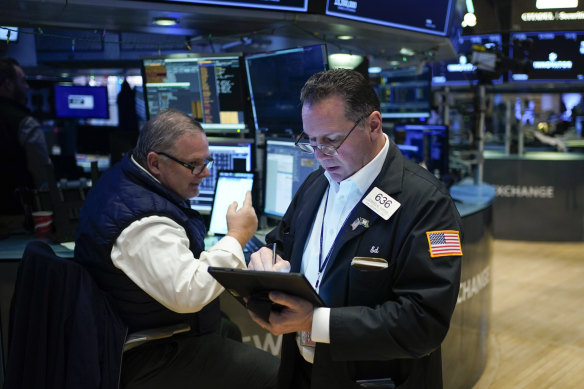The S&P 500 is technically still mired in a bear market, but a closer look below the surface shows that most of its stocks are in the midst of a big rally.
While the benchmark is down 17 percent from its record high set on January 3, 2022, about three-quarters of the stocks in the index are up 20 percent or more from their 52-week lows, according to data compiled by Bloomberg. Among the standouts are Wynn Resorts and Boeing, which have surged more than 60 percent in the past three months alone.

The ugly performance of a handful of technology-related stocks whose enormous market values is giving them greater influence over the S&P 500.Credit:AP
So why isn’t the S&P 500 ripping higher? Blame it on the ugly performance of a handful of technology-related stocks whose enormous market values give them greater influence over the index that is weighted by market capitalization. Just five stocks — Apple, Amazon.com, Tesla, Microsoft Corp and Meta Platforms — are responsible for nearly half the S&P 500’s losses over the past 12 months.
Apple and Microsoft, for example, each with market values of roughly $US2 trillion ($2.9 trillion), have a combined weighting of more than 11 percent in the S&P 500. That gives them more sway over the index’s performance than all the energy, materials and utilities companies in the benchmark. So even though American Airlines Group is up 34 percent this year, its 0.03 percent weighting does little to push the index higher.
To get a broader view on what’s happening with equities, some market professionals are watching a version of the S&P 500 that puts all the stocks at an equal weighting. That index is beating the S&P 500 by the widest margin since 2019 and is up 17 percent since hitting a low on September 30.
The equal-weighted index is important to follow because it offers a “deeper view” into the overall recovery, according to Dan Wantrobski, director of research at Janney Montgomery Scott. “This gives us more confidence that stocks should continue to base/bottom this year,” he said.
‘This gives us more confidence that stocks should continue to base/bottom this year.’
Dan Wantrobski, director of research, Janney Montgomery Scott
Stocks have rallied in the first two weeks of the year amid optimism that cooling inflation will prompt the US Federal Reserve to ease up on its most aggressive interest-rate rising campaign in decades. The S&P 500 advanced 2.7 percent this week after government data showed consumer prices rose in December at the slowest pace in more than a year.
Communication services and consumer discretionary stocks have been among the best performers in the S&P 500, with companies such as Warner Bros Discovery., United Airlines Holdings and Carnival Corp rallying more than 20 percent.